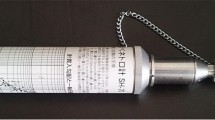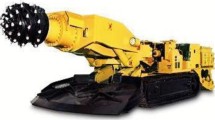Abstract
Rock excavation is carried out either by drilling and blasting or using rock-cutting machines like rippers, bucket wheel excavators, surface miners, road headers etc. Economics of mechanised rock excavation by rock-cutting machines largely depends on the achieved production rates. Thus, assessment of the performance (productivity) is important prior to deploying a rock-cutting machine. In doing so, several researchers have classified rockmass in different ways and have developed cuttability indices to correlate machine performance directly. However, most of these indices were developed to assess the performance of road headers/tunnel-boring machines apart from a few that were developed in the earlier days when the ripper was a popular excavating equipment. Presently, around 400 surface miners are in operation around the world amongst which, 105 are in India. Until now, no rockmass classification system is available to assess the performance of surface miners. Surface miners are being deployed largely on trial and error basis or based on the performance charts provided by the manufacturer. In this context, it is logical to establish a suitable cuttability index to predict the performance of surface miners. In this present paper, the existing cuttability indices are reviewed and a new cuttability indexes proposed. A new relationship is also developed to predict the output from surface miners using the proposed cuttability index.











Similar content being viewed by others
References
Atkinson T (1971) Selection of open pit excavating and loading equipment, transaction institution of mining and metallurgy–section A, pp A101–A129
Atkinson T, Cassapi VB, Singh RN (1986) Assessment of abrasive wear resistance potential in rock excavation machinery. Int J Min Geotech Eng 3:151–163
Barendsen P (1970) Tunnelling with machines working on the undercutting principle. In: Goodman JA (ed) The technology and potential of tunnelling. Proceedings of South African tunnelling conference, July, pp 53–58
Bilgin N, Seyrek T, Shahria K (1988) Golden horn clean up contributes valuable data, tunnels and tunnelling, June, pp 41–44
Bolukbasi N, Koncagul O, Pasamehmetoglu AG (1991) Material diggability studies for the assessment of bucket wheel excavator performance. Min Sci Tech 13:271–277
Dey K (1999) Performance analysis of continuous surface miners in an indian surface coal mine–a case study. Unpublished M. Tech dissertation submitted to Indian School of Mines, Dhanbad, pp 1–40
Einstein HH, Steiner W, Baecher GB (1979) Assessment of empirical design methods for tunnels in rock. Proceedings of conference on rapid excavation tunnelling. AIME, New York, pp 683–706
Eskikaya S, Tuncdemir H (2007) A handy tool for every type of tunnelling roadheader. J Mines Metals Fuels 55(12):524–538
Farmer IW (1986) Energy based rock characterization. In: Karamis M (ed). International proceedings of symposium on application of rock characterization techniques in mine design. AIME, Littleton, pp 17–23
Farmer IW, Glossop NH (1980) Mechanics of disc cutter penetration. Tunn Tunn 12(6):22–25
Fowell RJ, Johnson ST (1991) Cuttability assessment applied to drag tool tunnelling machines, Proceedings 7th international rock mechanics congress. ISRM, Aachen, pp 985–990
Franklin JA, Broch E, Walton G (1971) Logging the mechanical character of rock. transactions of institution of mining and metallurgy, Sec-A, pp. 1–9
Gehring KH (1980) Abb.4a. The voest alpine rock cuttability index
Gehring KH (1989) Bestimmung Von Schneidleistung und Meibelverbauch. Working paper of the Voest Alpine Ges.m.b.H. Zeltweg, Austria
Gehring KH (1992) Evaluation of Cutting Performance for VASM. Internal Report BBV, 1992-08-04, P102
Ghose AK (1996) Rockmass classification––a design tool for mining, civil. Eng Constr Ind 44(2):63–76
Graham PC (1976) Rock exploration for machine manufacturers. Proceedings of symposium on exploration for rock engineering, Johannesburg, pp 173–180
Hadjigeorgiou J, Scoble MJ (1990) Ground characterization for assessment of ease of excavation. In: Singhal RK, Vavra M (eds) Proceedings of international seminar on mine planning and equipment selection, pp 323–331
Hughes HM (1986) The relative cuttability of coal measure stone. Min Sci Technol 3:95–109
Karpuz C (1990) A classification system for excavation of surface coal measures. Min Sci Technol 11:157–163
Kirsten HAD (1982) A classification system for excavation in natural material. Civil engineering in South Africa, July, pp 293–307
Kolleth H (1990) Overview of open pit mines for mining technologies with high outputs. Bulk Solids Handl 10(1):29–35
Kramdibrata S (1998) The influence of rockmass and intact rock properties on the design of surface mines with particular reference to the excavatability of rock. Unpublished Ph. D. Thesis, School of Civil Engineering, Curtin University of Technology, P389
McFeat-Smith I, Tarkoy PJ (1979) Assessment of tunnel boring machine performance. Tunnels and tunnelling, December, pp 33–37
Minty EJ, Kearns GK (1983) Rockmass workability. Collected case studies in engineering geology, hydrogeology and environmental geology. In: Knight MJ, Minty EJ, Smith RB (eds) Special Publication Geological Society of Australia, No 11, pp 59–81
Natau O, Mutschler TH, Lempp CH (1991) Estimation of the cutting rate and bit wear of partial full face tunnelling machines, Proceedings 7th International Rock Mechanics Congress. ISRM, Aachen, pp 1591–1595
Pettifer GS, Fookes PG (1994) A revision of the graphical method for assessing the excavatability of rock. Q J Eng Geol 27:145–164
Rasper L (1975) The bucket wheel excavator. Transtech Publications, Clausthal-Zeller Feld, p 130
Roxborough FF (1987) The role of some basic rock properties in assessing cuttability. Proceedings of seminar on tunnels, wholly engineered structures, Sydney, I. E. Aust./AFCC, April, P122
Scoble MJ, Muftuoglu YV (1984) Derivation of a diggability index for surface mine equipment selection. Min Sci Technol 1:305–322
Singh RN, Denby B, Egretli I, Pathon AG (1986) Assessment of ground rippability in opencast mining operations. Mining Departmental Magazine, University of Nottingham, vol 38, pp 21–34
Thuro K (2003) Predicting roadheader advance rates: geological challenges and geotechnical answers, Invited Lecture––50th years Symposium of The Faculty of Mines, Istanbul Technical University The underground Resources of Turkey Today and Future, June 5–8, 2003, Istanbul, Turkey, pp 1241–1247
Weaver JM (1975) Geological factors significant in the assessment of rippability. Civil Engineering in South Africa, vol 17, pp 313–316
Author information
Authors and Affiliations
Corresponding author
Rights and permissions
About this article
Cite this article
Dey, K., Ghose, A.K. Review of Cuttability Indices and A New Rockmass Classification Approach for Selection of Surface Miners. Rock Mech Rock Eng 44, 601–611 (2011). https://doi.org/10.1007/s00603-011-0147-4
Received:
Accepted:
Published:
Issue Date:
DOI: https://doi.org/10.1007/s00603-011-0147-4




